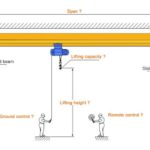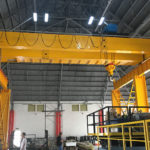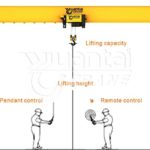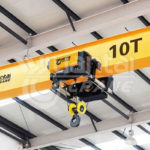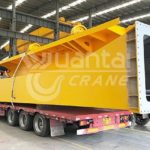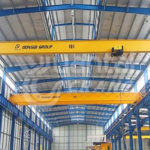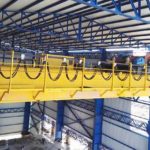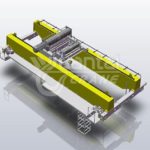What Is EOT Crane?|EOT Crane Meaning Philippines
An EOT (Electric Overhead Traveling) crane, also known as a bridge crane, is a type of crane characterized by its parallel runways with a travelling bridge spanning the gap. The lifting component of the crane travels along the bridge. EOT cranes in the Philippines are commonly used in industrial environments for moving heavy loads and materials across large areas. They are highly efficient and can be operated either from a control pendant, an operator cabin, or with remote wireless controls. The design of an EOT crane allows for precise handling and positioning of heavy objects, which is crucial in manufacturing and assembly operations.
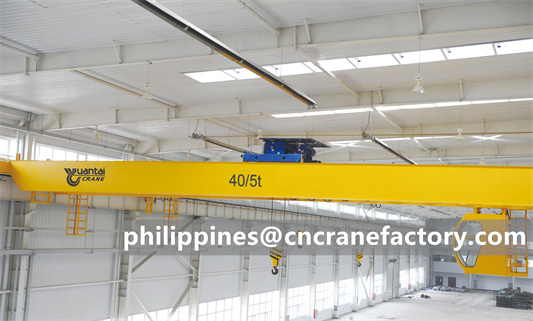
EOT Crane Types
Electric Overhead Traveling (EOT) cranes are versatile and widely used in various industries for material handling. They are essential in settings where heavy lifting and moving of materials are required. EOT cranes come in different types, each designed for specific tasks and operational requirements. The single girder EOT crane is designed with one main bridge and is often used for lighter loads and smaller work areas. In contrast, the double girder EOT crane features two main bridges, providing greater strength and load capacity, making it ideal for heavier lifting tasks and larger spaces. Top-running EOT cranes operate on rails that are mounted on the top of the runway beams, allowing for high lifting capacities without taking up floor space. Conversely, underslung EOT cranes have rails installed beneath the beams, which is beneficial in facilities with limited headroom. Here are the main types of EOT cranes:
- Single Girder EOT Cranes: These cranes consist of a single bridge girder supported on two end trucks. They have a single hoist, which runs along the bottom flange of the girder. Single girder cranes are typically used for lighter loads and shorter spans, with capacities generally up to 20 tons and spans up to 60 feet. They are preferred for workshops, warehouses, and light manufacturing facilities due to their cost-effectiveness and simplicity in design.
- Double Girder EOT Cranes: Double girder cranes have two bridge girders supported on two end trucks. They are equipped with a hoist trolley that runs on rails mounted on top of the girders. These cranes are suitable for heavy loads and longer spans, with capacities that can exceed 100 tons and spans that can reach up to 200 feet or more. They are used in heavy manufacturing, steel mills, heavy fabrication industries, and where high capacities and/or high lifting heights are required.
- Gantry Cranes: Although similar in operation to EOT cranes, gantry cranes differ primarily because they are supported on freestanding legs that move on rails embedded in the floor or on wheels. This design allows gantry cranes to operate in areas without an overhead runway structure. Gantry cranes are useful in outdoor applications such as shipping yards, construction sites, and places where overhead crane installation is not feasible.
- Semi-Gantry Cranes: These are a hybrid between gantry and EOT cranes. One end of the bridge is supported by an end truck running on an elevated runway, while the other end runs on a rail at ground level. Semi-gantry cranes are effective in workspaces where part of the area needs to be free of overhead structures, offering a mix of versatility and space efficiency.
- Under Running (Underhung) Cranes: These cranes operate on the lower flange of the runway beam, as opposed to the top, which is typical in other types of EOT cranes. Under-running cranes are typically used for light to medium applications, offering excellent hook approaches and ease of movement. They are ideal for facilities with limited headroom.
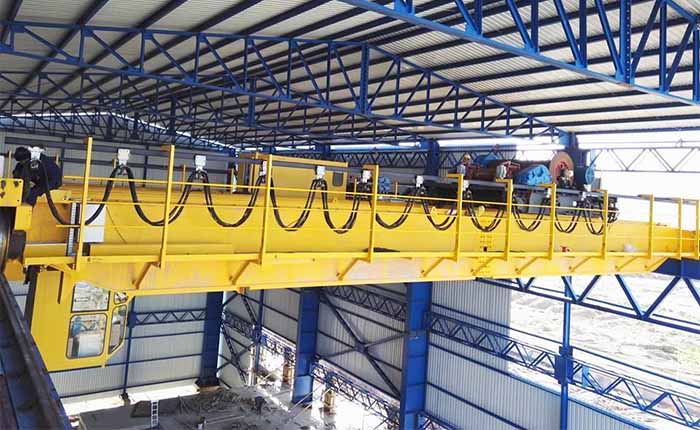
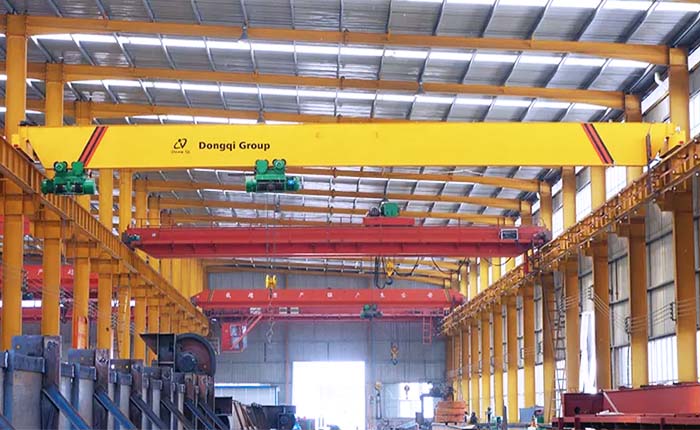
EOT Crane Brake Types
Electric Overhead Traveling (EOT) cranes are essential for material handling in various industries, enabling the movement of heavy loads across a wide area. The safety and efficiency of EOT cranes largely depend on their braking systems. Here are the main types of brakes used in EOT cranes:
- Electromagnetic Brakes: These are the most common type of brakes used in EOT cranes. They operate on the principle of electromagnetic force generation, which helps in the braking action. When electricity is supplied, the electromagnetic brake is activated, creating a magnetic field that exerts force on the brake disk, leading to the stopping or controlling of the crane’s motion. Electromagnetic brakes are reliable, provide instant braking, and can be easily controlled.
- Mechanical Brakes: These brakes operate based on mechanical force. They can be further classified into different types, such as shoe brakes, drum brakes, and disc brakes. In mechanical braking systems, a lever or pedal mechanism is used to apply force to the braking element (shoe, drum, or disc), creating friction that slows down or stops the crane’s movement. Mechanical brakes are simple in design and durable but require regular maintenance to ensure effectiveness.
- Hydraulic Brakes: Hydraulic brakes use fluid pressure to apply braking force. When the brake is engaged, hydraulic fluid is pushed into a cylinder, applying pressure to the brake pads or shoes, which then make contact with a drum or disc to create the necessary friction for braking. Hydraulic brakes are known for their smooth operation and powerful braking force but require a sealed system to prevent fluid leaks and maintain efficiency.
- Electric Brakes: Electric or regenerative brakes work by converting the crane’s kinetic energy back into electrical energy, which is then either dissipated as heat or fed back into the power system. This type of brake is more efficient in energy recovery and is often used in conjunction with other braking systems to enhance safety and control.
- Pneumatic Brakes: Similar to hydraulic brakes, pneumatic brakes use air pressure instead of hydraulic fluid to apply the braking force. Air is compressed and stored in a reservoir and, when activated, is released to apply pressure on the brake pads. Pneumatic brakes are fast-acting and reliable but require a constant supply of compressed air to function effectively.
Each type of brake has its advantages and is chosen based on specific requirements such as load capacity, speed, precision, and environmental conditions of the EOT crane operation. Proper selection, regular maintenance, and timely inspections of the braking system are crucial for the safe and efficient operation of EOT cranes.
EOT Crane Hook Types
The hook is a critical component of an Electric Overhead Traveling (EOT) crane, serving as the point of attachment for the load to be lifted or moved.
- Single Hooks: These are the simplest form of crane hooks, consisting of a single hook with a curved shape. Single hooks are commonly used for lifting lighter loads. They are straightforward in design and easy to use but are not suitable for very heavy or large loads because of the uneven distribution of weight that can lead to bending or failure.
- Double Hooks: Double hooks feature two symmetrical hooks that share a common shank. This design allows for a more even distribution of the load’s weight, making double hooks suitable for lifting heavier and bulkier items. Double hooks provide better balance and are often used in applications requiring high load capacities.
- C-Hooks: Named after their C-shaped profile, these hooks are designed for lifting and moving coils (e.g., steel coils) or other materials that can be inserted into the hook’s opening. C-Hooks are specialized tools that allow for quick and efficient handling of specific types of loads.
- Latch Hooks: Latch hooks come with a safety latch that automatically closes when lifting force is applied, preventing the load from slipping off the hook accidentally. They are used in various applications for added safety, especially when moving loads at height or over people.
- Grab Hooks: These hooks are designed with a special shape that allows them to grab onto parts of the load securely. They are often used in conjunction with lifting chains or slings and are ideal for loads that are not easily hooked by traditional means.
Each hook type offers unique advantages and is chosen based on the specific lifting requirements, including the nature of the load, the environment in which the crane operates, and safety considerations. Proper selection, regular inspection, and maintenance of crane hooks are essential to ensure the safety and efficiency of EOT crane operations.
EOT Crane Gearbox Types
The gearbox is a fundamental component of an Electric Overhead Traveling (EOT) crane, responsible for transmitting mechanical power from the crane’s motor to its moving parts, such as wheels or hoists.
- Helical Gearboxes: Helical gearboxes are among the most commonly used in EOT cranes. They feature helical gears that engage more gradually than straight-cut gears, providing smoother and quieter operation. This type of gearbox can handle high load capacities and is known for its durability and efficiency. The angled teeth create a thrust load but offer the advantage of less vibration and noise, making them suitable for applications requiring high speeds or heavy loads.
- Worm Gearboxes: Worm gearboxes consist of a worm (screw) that meshes with a worm gear (wheel). This design allows for high torque reduction between non-intersecting shafts at right angles, making it suitable for heavy-duty lifting applications where precise movement and control are necessary. Worm gearboxes have a high reduction ratio in a single-gear stage, but they tend to have lower efficiency due to sliding contact between the worm and the worm gear.
- Bevel Gearboxes: Bevel gearboxes use bevel gears to change the axis of rotation of the crane components, typically at a 90-degree angle. They are useful for angular transmission and are often employed in the bridge travel mechanism of EOT cranes. Bevel gearboxes can handle significant loads with a compact design, making them suitable for space-constrained applications.
- Planetary Gearboxes: Planetary (or epicyclic) gearboxes consist of one or more outer gears (planet gears) revolving around a central (sun) gear. This arrangement provides a high torque torque-to-weight ratio, making planetary gearboxes compact and efficient for their size. They are often used in hoisting mechanisms due to their ability to provide high torque output and precision control in a compact form factor.
- Spur Gearboxes: Spur gearboxes contain spur gears, which have straight teeth and are mounted on parallel shafts. While they are simpler and less expensive than other types, spur gearboxes can be noisier and less efficient at high speeds due to the direct contact between the gear teeth. They are typically used in applications where noise is not a critical issue and the operation is at lower speeds.
- Cycloidal Gearboxes: Cycloidal gearboxes use a cycloidal disc that moves in a cycloidal path to transmit power. This design offers high-speed reduction and is capable of handling high shock loads, making it suitable for heavy-duty applications in EOT cranes. Cycloidal gearboxes are known for their compactness, high efficiency, and excellent resistance to shock and overload conditions.
EOT Crane Uses in the Philippines
Electric Overhead Traveling (EOT) cranes play a crucial role in various industrial and construction sectors in the Philippines, thanks to their efficiency in handling heavy loads and facilitating the movement of materials over short to medium distances. Here are some of the primary uses of EOT cranes in the Philippines:
- Manufacturing Plants: EOT cranes are extensively used in manufacturing facilities, including automotive, electronics, and machinery manufacturing. They help in moving raw materials, handling parts during the manufacturing process, and lifting finished products for storage or shipment.
- Construction Sites: In the construction industry, EOT cranes are pivotal in lifting and positioning heavy materials such as steel beams, precast concrete sections, and large machinery. This facilitates the efficient construction of buildings, bridges, and infrastructure projects.
- Shipping and Logistics: Ports and warehouses in the Philippines utilize EOT cranes for loading and unloading cargo from ships and containers. These cranes are essential for the smooth operation of logistics and distribution networks, handling everything from bulk materials to heavy equipment.
- Power Plants: EOT cranes are used in power generation plants, including coal-fired, hydroelectric, and renewable energy facilities, for maintenance operations and the handling of heavy machinery parts such as turbines and generators.
- Metalworking and Steel Mills: The metal production sector relies on EOT cranes for the movement of raw materials like iron ore and scrap metal, as well as for handling hot ingots and moving finished steel products.
- Shipbuilding and Repair: In shipyards, EOT cranes are used for assembling ships and for the heavy lifting tasks involved in ship repair and maintenance. They handle large sections of ships, engines, and other components.
- Mining Operations: EOT cranes also find applications in the mining industry, where they are used for maintenance tasks, handling mining equipment, and moving mined materials.
Finding the Right EOT Crane for You
With a variety of EOT crane types, brakes, hooks, gearboxes, and applications to consider, choosing the right crane for your needs in the Philippines can seem overwhelming. Here are some key factors to keep in mind when making your decision:
Lifting Capacity: Determine the maximum weight you will need to lift.
Span Length: Measure the distance the crane needs to travel horizontally.
Lifting Height: Consider the required height for lifting and lowering loads.
Duty Cycle: Evaluate how frequently you will be using the crane throughout the day.
Application: Choose a crane type and features suitable for your specific industry and tasks.
Get a Free Quote on EOT Cranes in the Philippines
By understanding the different EOT crane types and their features, you can make an informed decision that optimizes your lifting and material handling operations. Contact a reputable EOT crane supplier in the Philippines today! They can help you assess your needs and recommend the perfect EOT crane solution for your business.
